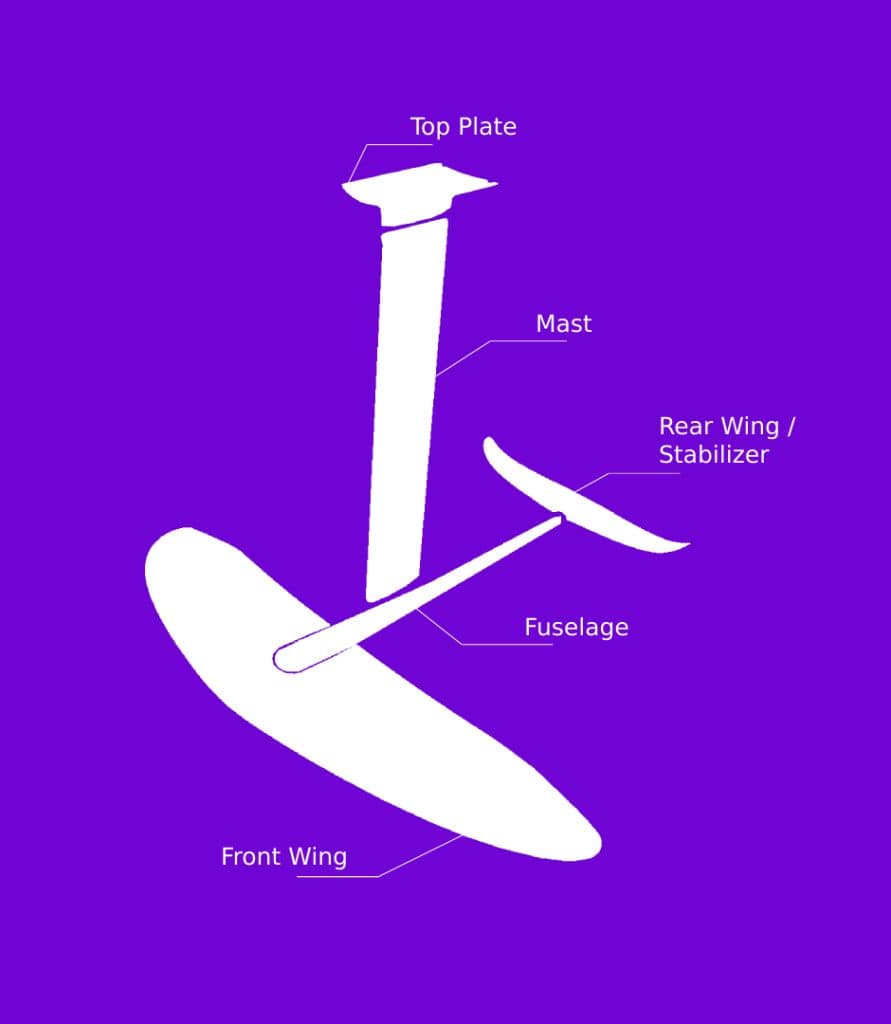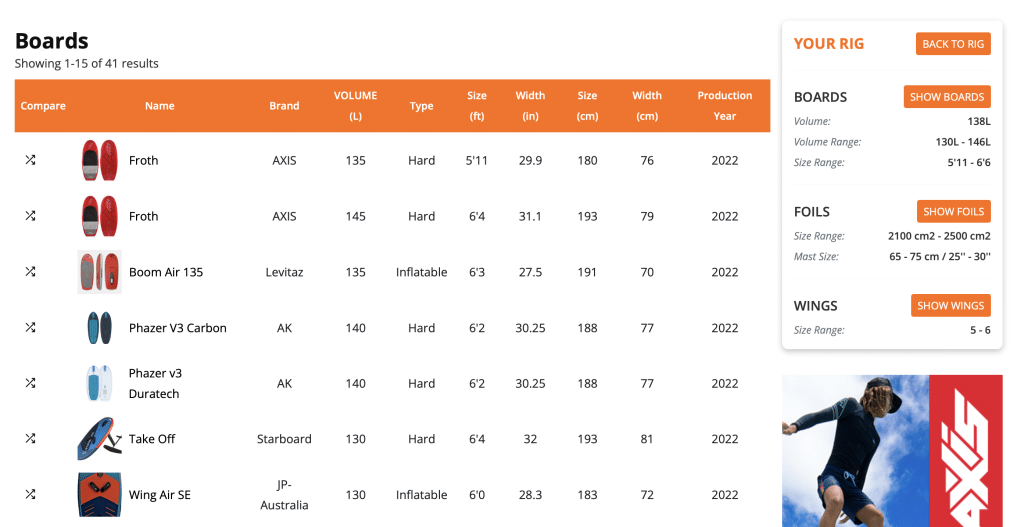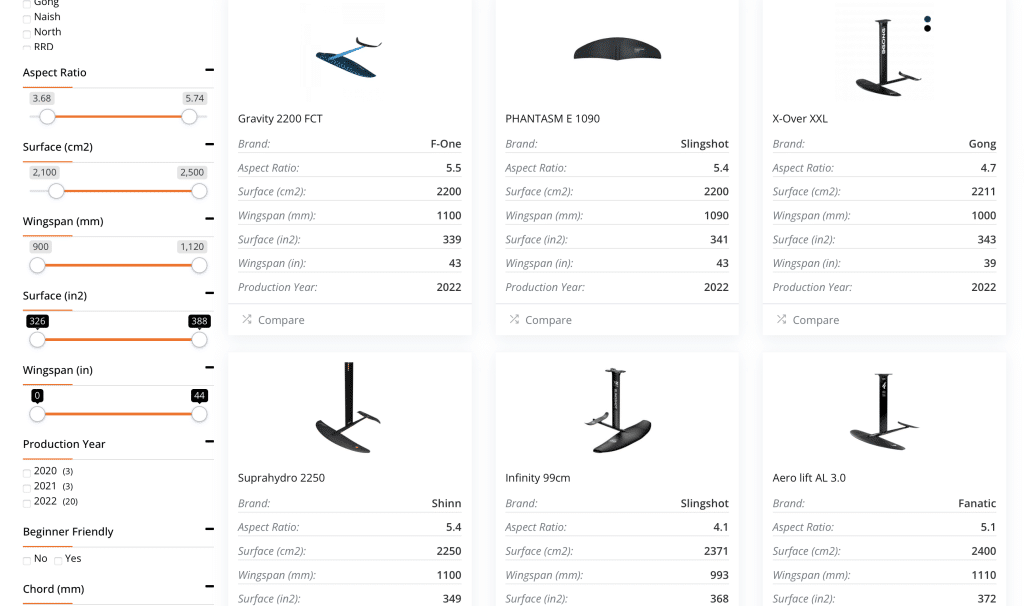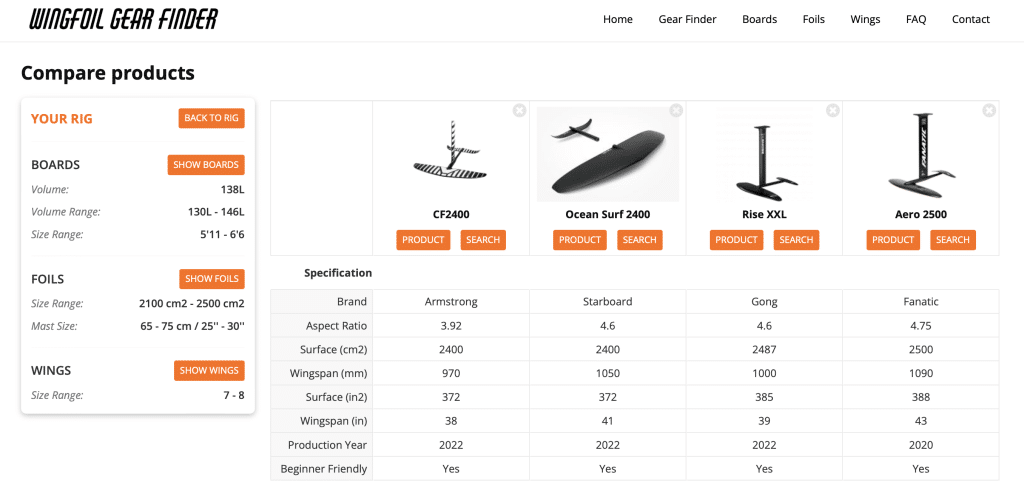Same as with board or wing choice. Best beginner foil for wingfoiling will be different from person to person depending on your home spot conditions, size, watersports experience, and athletic level.
Again, as a beginner you need any help you can get, which means that your foil should help you build confidence by being very forgiving, producing a controlled smooth lift at slow speed while being balanced and stable in all directions. Usually such foil setups include low to mid aspect ratio ( 3 – 6 ) front wings with generous wingspan and medium to long fuselages.
Fill out Wingfoil Gear Finder and we will calculate which foils fit you. You will receive recommended Size Range that will take any guesswork out of the equation. On top of that you will receive a list of foils which fit those parameters. These parameters are calculated based on inputs you have provided in the Wingfoil Gear Finder questionnaire so make sure you have provided correct data. If you will have a hard time selecting the foil yourself – feel free to Contact us.
What should a beginner know about foils?
Plain and simple, a foil or hydrofoil is basically an underwater airplane. Once that airplane reaches a certain speed it will takeoff and start flying i.e. lift you and your board above the water surface.
Foil Parts

Front wing
Most important part of your foil set up, responsible for generating lift, glide, controlling your rail to rail stability (roll), and carving (turning) performance. Wing is defined by following parameters:
- Surface Area: When it comes to foils, size matters! The surface area of a foil is crucial in determining how much lift it can produce and how easily it can be controlled. A larger foil will provide more lift but can be harder to maneuver and have limited top speed compared to smaller wings.
- Wing Span: is the distance between the tips of the foil wing. A larger wingspan means that your foil will have more rail-to-rail stability (roll) but will also be more challenging to turn. Shorter wingspan wings will be more agile and tighter in turns but have less stability, while larger wingspan foil turns will be long and wide.
- Chord: is a wing width, or mean distance between the leading and trailing edges.
- Aspect Ratio: is a key factor in determining foil wing performance and the conditions it is best suited for. The aspect ratio of a foil refers to the relationship between the wingspan and the chord or surface area. Understanding the aspect ratio and the specific characteristics of different types of hydrofoils will help you choose the right wing for your needs.
A high aspect ratio means the foil is wider and more slender, while a low aspect ratio means it’s more stubby and full. Low aspect foils are often easier for beginners to control and generate more lift at low speeds. However, they also produce more drag, reducing top speed and glide. On the other hand, high aspect foils are highly efficient, meaning a longer glide and less drag, but they also require more speed to produce lift.
Rear Wing / Stabilizer /Stab:
Often overlooked by beginners due to its size, but this small wing has a huge impact on your overall foil performance. As its name suggests it is responsible for nose to tail (pitch) stability. Bigger stabilizers provide more stability and lift, but reduce maneuverability and speed. So reducing its size will lead to faster and more responsive foil with longer glide.
You can completely change the performance of your foil by replacing the stabilizer while keeping the same fuselage and front wing. By changing the stab’s angle of attack using shims (small plates) we can increase or decrease lift of the entire foil.
Beginner setups are usually sold with a stab which matches the front wing.
Fuselage
Is what a hull is for an airplane (to be correct: fuselage is the original name for airplane’s hull). It is a rod to which the front wing, stabilizer and the mast (board) are connected. Apart from keeping the foil together, the fuselage is responsible for nose-to-tail (pitch) stability. Longer fuselages will provide more nose-to-tail stability. Shorter fuselages will be more responsive (read “unstable” from beginners perspective) and as such not recommended for beginners.
Mast
Connects your foil fuselage and board through the top plate. Shorter masts, although a bit more stable, are harder to pump because there is less room between the water surface and the board. Longer masts prevent your front wing from breaching by providing it more depth to “play” in.
- Below 65 cm / 25” – although there are very short masts available, and can help you overcome the intimidating nature of first flights, we do not recommend them to anyone apart from schools because you will outgrow them immediately.
- 65 – 75 cm / 25” – 30” – is the right size if your home spot is flatwater to slight chop
- 75 – 85 cm / 29” – 34” – is most common size which will enable you to ride any conditions
- Above 85 cm / 34” – are mostly used if your home spot is chop or wave
Top Plate
connects your mast and subsequently complete foil with your board, and allows you to change the position of the foil in the board foil box by sliding forward or backward.
What is an ideal beginner foil setup?
Based on everything mentioned above, ideal beginner foil setup would consist of:
- FRONT WING: low aspect + large surface + large wingspan to provide a lot of lift at small speeds while providing rail-to-rail stability through large surface and wingspan.
- Athletic beginners, and those with previous watersports experience might benefit from medium aspect + large surface + large wingspan front wing.
- FUSELAGE: medium to provide nose-to-tail stability
- MAST: 75 – 85 cm / 29” – 34” mast to tackle most conditions
- those intimidated by crashes from foil should start with 65 cm / 25″ mast
- MATERIAL: You as beginner will not feel the difference between Aluminum and Carbon versions. Usually it’s the same foil profile using different material. If you are on a budget, don’t despair because aluminum foil will behave same as it’s carbon cousin. Earn your carbon!
How to select the best beginner wingfoil foil?
For watersports novices, and especially those less athletic and/or suffering from poor mobility our recommended foil selection process is as follows
- Go to www.wingfoilgearfinder.com/#calculator to calculate the foil size which fits you.
- your results will consist of Size Range and Mast Size.

Size Range – This result gives you recommended Front wing size you should be looking for. This is our recommended size for someone of your experience, size and local conditions. Same as with wing and board selection – when in doubt – go BIG!
Remember that low aspect foils (3 – 4.5) will give you early lift at low speeds but also have low top speed and are great choice for those less athletic watersports novices while medium aspect ones (4.5 – 6) will need more speed to lift but also benefit from higher top speed and can be a great choice if you are athletic and more experienced in watersports.
Also good to remember is that foils with bigger / wider Wingspan will provide more rail-to-rail stability which is essential for beginners. Negative side is that such wings don’t carve or make tight but rather long and wide turns.
Mast Size– is our recommended mast size for your local conditions.
- click on the SHOW FOILS button from Your Rig results or Load More button at the bottom of results list.
- then use Filter sliders and options to narrow down foil Surface, Aspect Ratio, Wingspan, Brand, etc. according to your needs.

Use Compare button to select the foils for comparison and easily compare foils which interest you. Product button will take you to manufacturer product page, and Search button will open Google search for the given product so you can look for the availability of those products in your area.

Happy hunting!
